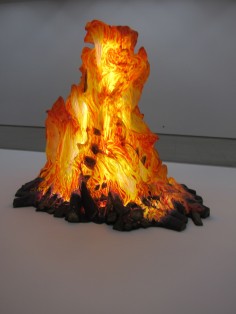Martin Honert
Fire
source: matthewmarks
Martin Honert’s meticulous sculptures are largely inspired by childhood memories. Employing illusion, manipulation of scale, and painstakingly rendered surfaces, they are obsessive depictions of essential ideas that connect to collective experiences. The artist has said, “I don’t want my work to get too personal. I may begin with a personal image, but then I try to see how I can formulate a more general one. . . . I don’t want to tell stories, so I try to reduce the image to its purest state.”
Honert (b. 1953) represented Germany in the 1995 Venice Biennale and had his first one-person exhibition in the United States at Matthew Marks Gallery, in 1999. The Staatliche Kunstsammlungen Dresden mounted a retrospective of his work in 2007. More recently, his work has been the subject of exhibitions at the Vancouver Art Gallery in 2012 and Hamburger Bahnhof, Berlin in 2013. Honert is a highly regarded teacher at the Hochschule für Bildende Künste Dresden. He lives and works in Düsseldorf and Dresden.
.
.
.
.
.
.
.
source: vanartgallerybcca
Fascinated by the way in which images are captured and how they evolve within our memories, Martin Honert creates sculptures that are wonderfully obsessive depictions of ideas connected to collective experience. Using illusion, manipulations of scale and meticulously rendered surfaces, the artist attempts to recall-often obliquely-his childhood in post-war Germany.
Honert’s works draw on family photographs, illustrations from schoolbooks and his own childhood drawings. Unlike many artists who focus on memory, however, he avoids nostalgia, seeking instead to make the image emotionally inert by isolating it from its original context and often dramatically shifting its scale. With this deliberate distancing he attempts, in his words, “to save an image before it dies within me.” The first museum exhibition of this artist’s work in North America, Martin Honert will feature a series of sculptures that reveal the breadth of Honert’s investigations into the potency of remembered images.


